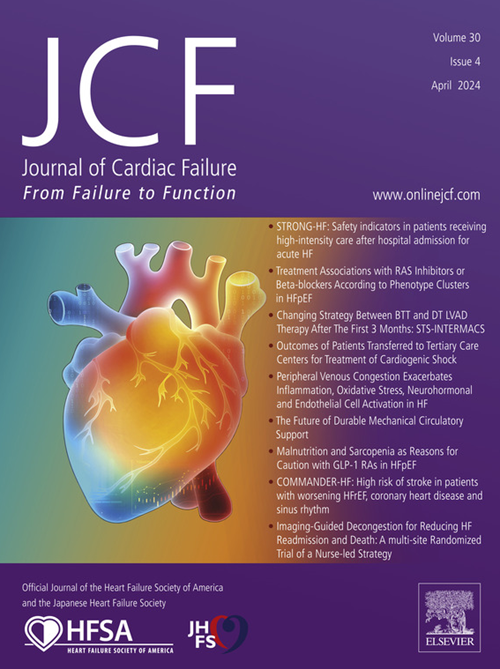平等的治疗,不平等的结果?揭开肾素-血管紧张素-醛固酮系统抑制剂减少心力衰竭住院率的种族差异。
IF 6.7
2区 医学
Q1 CARDIAC & CARDIOVASCULAR SYSTEMS
引用次数: 0
摘要
背景:肾素血管紧张素醛固酮系统抑制剂(RAASi)是射血分数降低型心力衰竭(HFrEF)患者的主要治疗药物,部分原因是为了防止患者住院。然而,RAAS 抑制剂是否能降低黑人患者的住院风险尚不完全清楚,因为在以前的临床试验中黑人患者的入选率很低,而且以前的一项荟萃分析表明存在明显的种族差异:使用 RAAS 抑制剂能降低白人患者的住院率,但不能降低黑人患者的住院率。以前的研究依赖于使用自我认定的种族而不是基因组血统。因此,本研究旨在调查自我认同的种族和基因组血统在 RAAS 抑制剂降低 HFrEF 住院率方面的种族差异中的作用:主要结果是首次心衰住院时间。方法:主要结果是首次心力衰竭住院时间。我们利用未/调整临床风险因素、作为竞争风险的死亡和随时间变化的 RAAS 抑制剂暴露的 Cox 比例危险模型,分析了心力衰竭患者登记(已去身份)和 GUIDE-IT 多中心随机对照试验的数据。对非洲约鲁巴血统的比例进行了量化。在注册表和 GUIDE-IT 中都进行了自我识别种族分析。由于 GUIDE-IT 无法提供基因组血统信息,因此仅在登记处进行了基因组血统分析。一项固定效应荟萃分析综合了登记处和 GUIDE-IT 的种族结果:结果:登记处共有 1010 名 HFrEF 患者(黑人 = 509 人,白人 = 501 人),其中 852 人有祖先量化(>80% 约鲁巴非洲祖先 = 381 人,80% 约鲁巴非洲祖先 = 0.93 [0.51-1.69] P = 0.80;结论:与之前的荟萃分析不同,GUIDE-IT 对 HFrEF 患者的祖先进行了量化:与之前的荟萃分析不同,这项对 2 个 HFrEF 患者数据集的现代分析表明,在 RAAS 抑制剂相关的心衰住院率降低方面不存在种族差异。随着时间的推移,这种种族差异可能是由于背景心衰疗法的改进、医疗保健使用方面的种族差异以及使用了更先进的统计方法。本文章由计算机程序翻译,如有差异,请以英文原文为准。
Equal Treatment, Unequal Outcomes? Debunking the Racial Disparity in Renin Angiotensin Aldosterone System Inhibitor–Associated Reduction in Heart Failure Hospitalizations
Background
Renin angiotensin aldosterone system inhibitors (RAASi) are a mainstay treatment in patients with heart failure with reduced ejection fraction (HFrEF) in part to prevent hospitalizations. However, whether RAASi reduce the risk of hospitalization in Black patients is not entirely clear because enrollment of Black patients in previous clinical trials was low and a previous meta-analysis showed a significant racial disparity: reduction in hospitalizations with an RAASi in White patients but not Black patients. Previous studies relied on the use of self-identified race instead of genomic ancestry. Therefore, this study aimed to investigate the role of self-identified race and genomic ancestry in the racial disparity in RAASi–associated reductions in HFrEF hospitalizations.
Methods
The primary outcome was time to first heart failure hospitalization. Data from the Henry Ford Heart Failure Pharmacogenomic Registry (HFPGR) and the GUIDE-IT multi-center randomized control trial were analyzed with Cox proportional hazards models un/adjusted for clinical risk factors, death as a competing risk, and time-varying RAASi exposure. The proportion of Yoruba African ancestry was quantified. Analyses of self-identified race were performed in both the HFPGR and GUIDE-IT. Analysis of genomic ancestry was only performed in the HFPGR since this information was not available in GUIDE-IT. A fixed effect meta-analysis combined results of both the HFPGR and GUIDE-IT for race.
Results
The HFPGR had 1010 total HFrEF patients (Black = 509 and White = 501) with 852 having ancestry quantification (>80% Yoruba African Ancestry = 381 and <5% Yoruba African Ancestry = 471). GUIDE-IT had 810 HFrEF patients (Black = 322 and White = 488). There was no significant difference in the association of RAASi exposure with heart failure hospitalization by race (meta-analysis P value for race*RAASi exposure interaction = .49; Black patients hazard ratio [HR, 95% confidence interval] for RAASi exposure = 0.89 [0.64–1.23)], P = .47; White patients = 1.20 [0.83–1.75], P = .34). Results were similar when analyzed by ancestry (P value for ancestry*RAASi exposure interaction = 0.57; >80% Yoruba African Ancestry = 0.93 [0.51–1.69], P = .80; <5% Yoruba African Ancestry = 1.29 [0.57–2.92], P = .54).
Conclusions
In contrast to a previous meta-analysis, this more contemporary analysis of 2 HFrEF patient datasets demonstrates the absence of a racial disparity in RAASi–associated reductions in heart failure hospitalizations. The difference in this racial disparity over time may be due to improvements in background heart failure therapies, racial differences in health care usage, and the use of more advanced statistical approaches.
求助全文
通过发布文献求助,成功后即可免费获取论文全文。
去求助
来源期刊

Journal of Cardiac Failure
医学-心血管系统
CiteScore
7.80
自引率
8.30%
发文量
653
审稿时长
21 days
期刊介绍:
Journal of Cardiac Failure publishes original, peer-reviewed communications of scientific excellence and review articles on clinical research, basic human studies, animal studies, and bench research with potential clinical applications to heart failure - pathogenesis, etiology, epidemiology, pathophysiological mechanisms, assessment, prevention, and treatment.
 求助内容:
求助内容: 应助结果提醒方式:
应助结果提醒方式:


